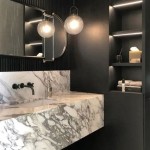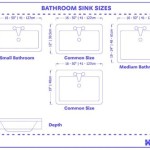Bathroom Design Ideas For Small Spaces
Small bathrooms present unique design challenges. Optimizing space is paramount, requiring creative solutions that maximize functionality without sacrificing aesthetics. Careful planning and the selection of the right fixtures and design elements are crucial for transforming a cramped bathroom into a comfortable and efficient space.
Space-Saving Fixtures and Fittings
One of the most impactful ways to maximize space in a small bathroom is by selecting appropriately sized fixtures. Standard-sized toilets, vanities, and bathtubs can overwhelm a smaller room, making it feel even more confined. Compact alternatives are readily available and offer similar functionality in a more streamlined form.
Wall-mounted toilets and sinks, for example, free up floor space, creating a visual sense of openness and making cleaning easier. The absence of a pedestal under the sink or a base around the toilet allows the eye to travel further, making the room appear larger. These fixtures also often have a minimalist design, which complements the overall aesthetic of a small bathroom.
Corner sinks are another excellent option for bathrooms where space is limited. They fit neatly into corners, utilizing areas that might otherwise be wasted. Similarly, corner showers can maximize space while providing a functional showering area. The key is to choose fixtures that are specifically designed for small spaces, rather than trying to squeeze in standard-sized options.
Replacing a traditional bathtub with a shower can significantly free up floor space. If a bathtub is essential, consider a smaller, more compact bathtub or a shower-tub combination designed for smaller bathrooms. The goal is to find fixtures that meet the functional needs of the user while minimizing their physical footprint within the room.
Beyond the larger fixtures, the choice of smaller fittings also contributes to a space-saving design. Opt for sleek, minimalist faucets and showerheads that don't visually clutter the space. Consider installing a towel ladder rather than bulky towel bars, as this offers vertical storage without taking up valuable wall space. Every detail, from the toilet paper holder to the soap dish, should be chosen with space efficiency in mind.
Strategic Use of Color and Light
Color and light play a critical role in the perception of space. Lighter colors reflect light and create a sense of openness, while darker colors tend to absorb light and make a space feel smaller and more enclosed. In a small bathroom, it is generally advisable to use a light and bright color palette to maximize the feeling of spaciousness.
White is a classic choice for small bathrooms, as it reflects light effectively and creates a clean, minimalist aesthetic. However, other light and neutral colors, such as beige, cream, light gray, and pastel shades, can also work well. These colors can be used on the walls, floors, and fixtures to create a cohesive and airy feel.
Introducing pops of color through accessories, such as towels, shower curtains, or artwork, can add visual interest without overwhelming the space. However, it is important to use color sparingly and avoid creating a cluttered or chaotic look. A single accent wall or a few strategically placed colorful accessories can be more effective than painting the entire room in a bold color.
Natural light is a valuable asset in any bathroom, but it is particularly important in small spaces. Maximize natural light by keeping windows uncovered or using sheer curtains or blinds that allow light to filter through. If natural light is limited, consider installing additional lighting fixtures to brighten the space.
Recessed lighting is a good option for small bathrooms, as it provides ample illumination without taking up valuable space. A well-placed vanity light can brighten the mirror area and make the room feel more inviting. Consider adding accent lighting, such as a small sconce or a strip of LED lights, to highlight specific features of the room.
Mirrors are also essential for maximizing the perception of space. A large mirror can create the illusion of a larger room by reflecting light and the surrounding environment. Consider installing a mirror that spans the entire length of the vanity to create a dramatic and spacious effect. Mirrored medicine cabinets provide both storage and reflective surfaces, further contributing to the feeling of openness.
Smart Storage Solutions
Effective storage is crucial in a small bathroom. Clutter can quickly overwhelm a small space, making it feel even more cramped and disorganized. Implementing smart storage solutions is essential for keeping the bathroom tidy and functional.
Vertical storage is particularly valuable in small bathrooms. Shelving units installed above the toilet or along the walls can provide ample storage for toiletries, towels, and other bathroom essentials. Consider using floating shelves, which create a clean and minimalist look while maximizing storage space.
Under-sink storage is another important area to consider. A vanity with drawers or cabinets can provide storage for personal care items, cleaning supplies, and other bathroom necessities. Look for vanities with built-in organizers or shelves to maximize the use of the available space.
Medicine cabinets are a classic storage solution for bathrooms. Recessed medicine cabinets save space by fitting flush against the wall, while mirrored doors provide a convenient place to check one's appearance. Choose a medicine cabinet with adjustable shelves to accommodate items of different sizes.
Utilizing the space behind the door is another often-overlooked storage opportunity. Install hooks or an over-the-door organizer to hang towels, robes, or other items. This can free up valuable space in the rest of the bathroom.
Consider using baskets and containers to organize items within drawers, cabinets, and shelves. This can help to keep things tidy and prevent clutter from accumulating. Clear containers allow you to easily see what's inside, making it easier to find what you need.
If space is particularly tight, consider repurposing other items for storage. For example, a decorative ladder can be used to hang towels, or a small stool can be used as a makeshift shelf. Creative thinking can help to uncover unexpected storage opportunities in even the smallest bathrooms.
Built-in niches in the shower or bath area provide convenient storage for shampoo, conditioner, and other bath products. These niches can be designed to blend seamlessly with the surrounding tile, creating a clean and streamlined look. Avoid using suction-cup shelves, as they can be unsightly and prone to falling.
In conclusion, designing a small bathroom requires careful planning and attention to detail. By selecting space-saving fixtures, strategically using color and light, and implementing smart storage solutions, it is possible to transform a cramped and cluttered bathroom into a functional and aesthetically pleasing space. The key is to prioritize efficiency and minimalism, creating a design that maximizes the use of available space without sacrificing comfort or style.

10 Tips To Create Stunning Bathroom Designs In Small Spaces Arch2o Com

Small Bathroom Ideas To Amp Up Designs 20

Small Bathroom Design Ideas For Your Home Designcafe

Tips For Designing A Small Bathroom With Decor Ideas Design Miya Interiors
:strip_icc()/6.MindyGayerDesign_VanessaLentine-3-8b975d37102d4fdbaf4d036bbe93fa7e.jpg?strip=all)
Small Bathroom Ideas To Make Your Space Feel So Much Bigger

61 Small Bathroom Ideas 2024 Remodeling Decor Design Solutions

9 Big Space Saving Ideas For Tiny Bathrooms

55 Cozy Small Bathroom Ideas For Your Remodel Project Art And Design Very Shower Room

10 Small Bathroom Ideas And Design Tricks

Small Bathroom Ideas To Create Beautiful Toilet Designs Livspace
Related Posts







